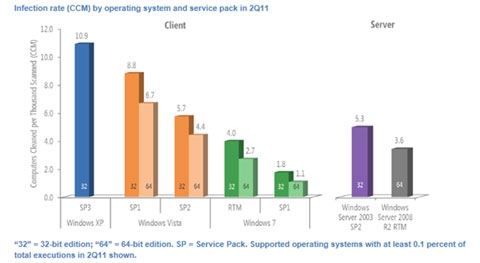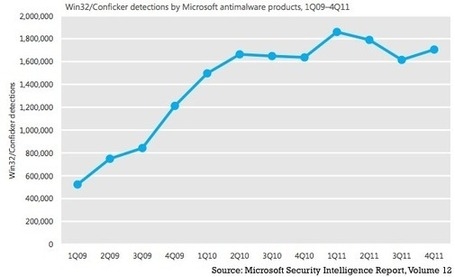Microsoft security intelligence report warns ongoing conficker threat

The study also revealed the worm continues to spread because of weak or stolen passwords and vulnerabilities for which a security update exists.
According to the SIRv12, quarterly detections of the Conficker worm have increased by more than 225 per cent since the beginning of 2009. In the fourth quarter of 2011 alone, Conficker was detected on 1.7 million systems worldwide. In examining the reasons behind Conficker’s prevalence in organisations, research showed that 92 per cent of Conficker infections were a result of weak or stolen passwords, and 8 per cent of infections exploited vulnerabilities for which a security update exists.
“Conficker is one of the biggest security problems we face, yet it is well within our power to defend against,” said Tim Rains, director of Microsoft Trustworthy Computing. “It is critically important that organisations focus on the security fundamentals to help protect against the most common threats.”
The SIRv12 also revealed that many of the threats often referred to as Advanced Persistent Threats (APTs) are no more advanced or sophisticated than other types of attacks. In most cases, these attacks leverage known vectors such as exploiting weak or stolen passwords and vulnerabilities for which security updates exist, but their success lies in the persistence and determination in trying different tactics to compromise the target. This is why Microsoft refers to these types of threats as Targeted Attacks performed by Determined Adversaries, rather than APTs.
“Labeling cyberthreats as ‘advanced’ is often times misleading and can divert organisations’ attention away from addressing basic security issues, which can prevent more common threats from infiltrating their systems,” Rains said. “Most attacks do not possess new, super-advanced techniques or technology as the APT label implies, in the majority of cases, they simply exploit weak or stolen passwords or vulnerabilities for which a security update exists and employ social engineering.”

Microsoft recommends that customers and businesses adhere to the following security fundamentals to help ensure they are protected:
- Use strong passwords and educate employees on their importance
- Keep systems up to date by regularly applying available updates for all products
- Use antivirus software from a trusted source
- Invest in newer products with a higher quality of software protection
- Consider the cloud as a business resource
“With organisations being presented with significant amounts of data and media reports on cyberthreats, the SIRv12 gives us good perspective on recent trends in the global threat landscape,” said Bob Rodger, global head of IT Infrastructure Security at HSBC. “The report, in combination with other sources of intelligence, assists us to more accurately and effectively invest, prioritise and make informed decisions about our security infrastructure to ensure that our business continues to be optimally protected from threats.”
For businesses, as Scott Charney, corporate vice president of Microsoft Trustworthy Computing, outlined in his keynote presentation at RSA 2012, Microsoft recommends a more holistic approach to risk management to help protect against both broad-based and targeted attacks, including the following:
- Prevention.Employ security fundamentals and pay close attention to configuration management and timely security update deployment.
- Detection.Carefully monitor and perform advanced analysis to identify threats. Keep abreast of security events and leverage credible sources of security intelligence.
- Containment.If the targeted organisation has configured its environment with targeted attacks by determined adversaries in mind, it is possible to contain the attacker’s activities and thereby buy time to detect, respond to and mitigate the attack. To contain an attack, consideration should be given to architecting domain administration models that limit the availability of administrator credentials and apply available technologies, such as IPsec-based network encryption, to restrict unnecessary interconnectivity on the network.
- Recovery.It is important to have a well-conceived recovery plan, supported by suitably skilled incident response capability. Maintain a “crisis committee” to set response priorities and engage in exercises to test the organisation’s ability to recover from different attack scenarios.
Microsoft produces the SIR twice per year to keep the industry informed on the changing threat landscape and provide actionable guidance for customers in an effort to create safer more trusted computing experiences for everyone. The latest report, volume 12, provides insight into online threat data with new information for July 2011 through December 2011 and analysis of data from more than 100 countries and regions around the world.
What the stars mean:
★ Poor ★ ★ Promising ★★★ Good ★★★★ Very good ★★★★★ Exceptional
 Tag:
Tag:
Related Contents
Latest News
More News
- Takeda supports health resilience amid climate change challenges (December 18, 2025 | 12:39)
- Mondelez Kinh Do - a chapter of purpose-led leadership in Vietnam (December 18, 2025 | 09:44)
- VNPAY services receive the highest-level PCI DSS international security certificates for six consecutive years (December 17, 2025 | 23:47)
- PPL extends its reach into ASEAN (December 17, 2025 | 15:44)
- Over 600 BUV graduates meeting quality benchmarks across triple quality assurance levels (December 17, 2025 | 13:00)
- HEINEKEN Vietnam partners with Ho Chi Minh City Traffic Police on road safety drive (December 17, 2025 | 09:42)
- BUV and China’s CSCSE sign MoU to boost educational cooperation (December 17, 2025 | 08:00)
- PVT Logistics honoured with ‘Fast Enterprise Award’ at APEA 2025 (December 16, 2025 | 18:22)
- Empowering Sustainable Data Centers with Smart Infrastructure Solutions (December 16, 2025 | 13:59)
- Vietjet wins gold ESG transport sustainability award in Taiwan (China) (December 13, 2025 | 22:03)
























 Mobile Version
Mobile Version